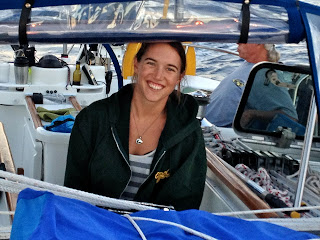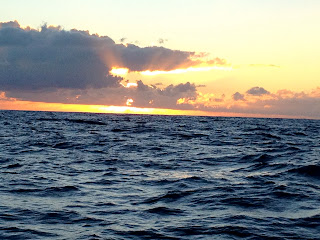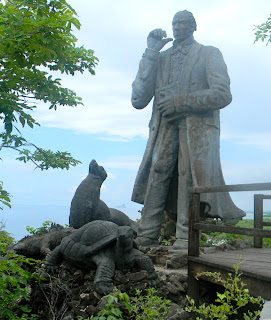Wow, it feels like it has been forever. I am sorry if I worried some of you with my lack of communication, the last few weeks have been much more hectic and adventurous than was expected . . . I guess that is how the real adventures often are ;) Thought I would send a lengthy update on the latest adventure, since I have been failing on the blogs . . . ease some minds and inspire others ;)
We concluded an amazing 2 months of adventuring and island hopping French Polynesia with a May 16th departure from Bora Bora to Suwarrow Island of the Cook Islands. Those 2 months in French Polynesia are in dire need of their own posts so we will save those updates for laterSuwarrow is a mostly uninhabited island in the middle of the Pacific Ocean, part of the New Zealand Cook Islands, most well known as home to Tom O'Neal and inspiration for his book, "An Island to Oneself". There are 2 caregivers that live on the tiny island 6 months out of the year but we had permission by the World Arc to visit the island before they arrived, so it was literally an island to ourselves (and the other half of the World Arc fleet that we would be arriving with). We had to sail there in 2 groups since the anchorage could not hold all of the World Arc fleet. We opted to stay in Bora Bora with my mom for a couple more days and arrive with the second group of boats to this little oasis. These may all sound like boring details, but all a culmination of the adventures that came.
It was a quick 6 day sail to the paradise of Suwarrow. We had no idea what to expect but my breath was literally taken away when we got there. It was the most crystal blue waters looking down into white sand and huge bright coral heads just offshore of swaying palm trees and hundreds of little reef sharks that were like puppy dogs greeting the boats. We anchored amidst the other boats in the tiny bay with a picturesque view of the island and the little hand made hut onshore where we gathered for bbqs for the next week. It was truly paradise! Some of the most amazing snorkeling I have ever done in my life with HUGE tropical fish that cruise right up to you with no idea that in other non idyllic locations there is actually a threat to their lives.
We were scheduled by the World Arc to stay in Suwarrow for 72 hours and had an amazing 3 days adventuring around the island, cracking open fresh coconuts, feasting on fresh caught bbq'd tuna, swimming with endless reef sharks and giant parrot fish, drift diving through the pass, paddle boarding into the sunset on glass calm water, dance parties on the yachts at night with guitars and saxophone serenades . . . and then came the weather.
A weather system was forming while we were gallivanting in the beautiful sunshine of Suwarrow so all the boats that were at the island, 15 in total, concluded that we would wait out the potential of a hurricane in the small anchorage of Suwarrow rather than brave the seas to our next destination of Niue. We had no idea what was coming our way.
Started with a rainy afternoon, where Kelsey, Shadow and I cooked brownies to deliver to all the boats. When we got in the dingy to make our deliveries, it was clear after the first 3 boats that we were in trouble and needed to get back to the boat. The waves had picked up SO fast and we were surrounded by huge swells and wind that we could hardly see through, all within 10 minutes. We made it safely back to SV Zoe, tied up the cheeky dingy and hunkered down to watch the storm and our anchor as the sun was setting through gray stormy skies. We were anchored close enough to the reef that if our anchored was pulled up by the waves we would crash into the reef so we were all on close watch. That watch quickly got very scary.
As the waves and wind continued to pick up to 40 knots (potential hurricane status) it became clear that many of the boats needed to pull anchor and get away from the reef, FAST! We watched 5 or 6 boats try to pull their anchors up, tossing and turning in the waves, struggling to get their anchors free from the coral heads they had become wrapped around. There was a tough debate at that moment to try and pull anchor and move (risking loosing your anchor, running over a large baumy coral head on your way out to anchor deeper in the sea but safe from reefing on shore) or stay put and pray that you are wrapped tightly around coral heads and the waves won't pull up your anchor (but risking that could be a scenario and you would need to move the boat fast). As crew of SV Zoe, watching all the boat around us struggle and almost flip in the waves, we decided to stay put and stay on anchor watch through the night to make sure if our anchor did slip we would have the engine on and ready to motor away from the reef. We all felt that was the best decision for how far we were from the reef. As we sat in the cockpit trying to feel confident and comfortable with that decision, we watched a disaster unfold right in front of us.
The catamaran, Ensemble, anchored directly between us and the shore (aka reef). They had decided to trust their anchor as well, and although they were MUCH closer to the reef than we were, they have a shallower draft so can sit in much shallower water and still be fine. We watched their boat nervously thinking that it was too close to the reef, which became apparent to them as well. As soon as David and Magali (newlywed owners of Ensemble) tried to lift their anchor, it was clear that there was a huge problem. They could not get their anchor free and were quickly being pushed by the waves closer and closer to the sharp coral reef. Then the MAYDAY came over the radio from Magali that they had hit coral and needed help. Immediately the most experienced sailors in our crew headed over to Ensemble, making heroic journeys from dingys to boarding their boat in massive waves. Mike and Richard (Captains from 2 other yachts in our fleet) cut the anchor and soon Ensemble was motoring away from the reef but was in no way safe.
The crash against the coral had ripped the fiberglass on one of their hulls and the catamaran was taking on water, a lot of water and quickly. As soon as they got far enough away from the reef, a call was made over the radio for all assistance that could be offered; people, crash mats, puddy, drills, pumps, buckets, tape, anything and everything. There were decisions being made to beach the boat but there were no safe beaches nearby so all available hands put on life jackets and were picked up by Sapphire's and Wind Dancers' dingys (the only 2 dingy that could get through the waves). When Sapphire's dingy arrived at our boat to pick up all the materials we could find to donate, it was decided that I would brave the journey to Ensemble to help comfort Magali. I secured my life jacket and as I was jumping into that tumultuously rocking dingy in the black night with pumps and buckets in hand, I was a bit overwhelmed by just how real the situation was.
Arriving at Ensemble (after delivering a young child that was stranded on land that we found almost drowning and clenching onto his surf board back to his boat) was another reality check. The catamaran had taken on so much water that it was heeled over with one hull almost completely submerged and the other floating above the water. I took a deep breath and hopped on board. My heart was immediately warmed to see so many World Arc participants running rhythmically with full buckets and material, doing everything they possibly could to make sure that boat didn't sink. We were SO lucky to have been with the boats we were in that there were 2 professional captains within the second group of yachts and another 4 boats with young, strong, skilled men that knew exactly what to do. I immediately went to cleaning glass that was shattered all over the kitchen and dining area and then found Magali, wrapped in a cashmere blanket at the helm watching the navigation screen to make sure the anchor doesn't slip.
We sat at that helm, under that cashmere blanket long into the dark night talking about anything that was as far away from topic of boats and water that we could. We actually laughed pretty hard at times, completely and purposefully forgetting that there was a mini militia of life jacketed men scurrying beneath us in attempt to not let her new boat sink. We would get updates from one or two of the guys every hour or so and when the buckets seemed to be less frequent and the life jackets started to be unhooked and thrown up to dry, we decided the anchor was holding well and it was time that we came down from our perch to survey the scene. Being that Magali is a chef in the process of writing a cook book, she just so happened to have 2 gourmet pizzas in the fridge that she was planning on cooking that evening for dinner (in addition to the chocolate truffle cake that was in the over, are you serious? ha) We enjoyed ridiculously delicious pizza and truffle cake and were comforted that the leak was getting manageable . . . their boat was not going to sink! At least not tonight.
A few of the Captains devised a watch schedule for Ensemble to ensure there were plenty of hands on deck throughout the night to keep pumping water out. I was asked to stay until 3am. By about 1am the leak was really under control and it was just a matter of turning on the emergency pump every 10 minutes to drain water (thanks to a donation of SV Zoe . . . same pump we used in the middle of the Atlantic Ocean in our attempts to get to St. Lucia when we had to divert to Bahamas . . . some of you will remember this story ;) ha) At 3am I was delivered back to SV Zoe in almost a dream like state and utterly exhausted but elated that Ensemble was still afloat.
The next couple days were filled with everyone coming together to continue to patch Ensemble. A few of the boats had dive gear on board and were really helpful in patching the holes from underwater (screwing on crash mats and using the rubber puddy stuff . . . more donations from SV Zoe that really helped ;) After a couple days and no help from their insurance agency or the World ARC organization, there was a difficult decision that needed to be made: abandon Ensemble and risk loosing the boat before professional help comes, or have faith that the patchwork will hold and the boat will be sea worthy enough to get to the closest port of American Samoa. The remaining boats decided to have faith in the latter decision and a new fleet was organized with 7 boats that would sail side-by-side with Ensemble all the way to American Samoa (about a 5 day sail). It was also decided that they needed more crew on board, should anything happen. The other 8 boats with extra crew had already left Suwarrow for their next destination and of the 7 boats that would accompany Ensemble to American Samoa, our boat was the only boat with extra crew. So, Shadow and I packed our life jackets, 2 changes of clothes, NO valuables and headed onto Ensemble fully being aware that we might be hopping into a life raft in the middle of the Pacific Ocean should that patchwork fail.
It was a 5 day sail to American Samoa and as stressful as can be expected. Shadow and I were actually sleeping over the leak with the floor boards open so we could check the bilges every half hour to make sure no excess water was coming in that the bilge pumps couldn't handle pumping out. Shadow and I stood on watch at least 10 hours a day so that Magali and David could get as much sleep as possible. I woke up one morning (3 days into the journey) for my 9am watch and looked down to see one of the bilges almost overflowing with water. I immediately went up to tell David that I think the leaks are opening and we need to start pumping water. Shadow and I hooked up Zoe's "Oh SHit" pump and simultaneously started bucketing water while David put a radio call into the fleet that we were taking on water. One of the other boats immediately lined up informing the Coast Guard and a plan was being formed if we had to jump ship. When an "aha moment" struck and David asked us if the bilges were clogged. We immediately started our surgery on the bilge pump to find it filled with all kinds of little parcels (card board, plastic bits, CORAL). Although we had cleaned the bilges thoroughly, these bits must have been in there from the accident and finally clogged the pump so that it could not pump out water. Quick fix and we were making way again without worry of jumping ship just yet or calling a MAYDAY out to the coast guard.
We made it safely into the tuna aroma and e.coli waters of American Samoa in 4 1/2 days with all 7 of the World Arc boats that braved the dangerous journey with us directly behind us as we entered the harbor. My eyes welled up to see those boats so close behind us and so dedicated to getting this boat in safely. Ensemble is being pulled out of the water tomorrow since both their bilge pumps have now failed from being overworked and the beautiful new 51 foot French Catamaran will most likely find a new home aboard a cargo shipped next week and sent to New Zealand for potential repairs or to be decided as a total loss.
This entire journey has been remarkable so far and these last couple weeks were just highlights of that. It was an intensely scary situation and a great reminder of how powerful the sea is, but to watch so many people come together to support without question, even if it meant risking at some points their safety and their own boats . . . is remarkable. I am beyond thankful for this sailing community and the group we are travelling these waters with (well, at least some of them ;) It will be an emotional good-bye to Ensemble tomorrow as we continue on our journey and set sail for Tonga to re-meet up with the rest of the fleet but all of us are beyond thankful for the adventures shared together and that we all made it here in one, healthy piece . . . the boat included ;)
Below are a few photos that a friend took of Suwarrow before the storm hit. Capturing the beauty that I want to remember of such an incredible island ;)
Photo credit to the amazing Daniel from SY Blue Lotus, thank you for capturing such beautiful images !





















































